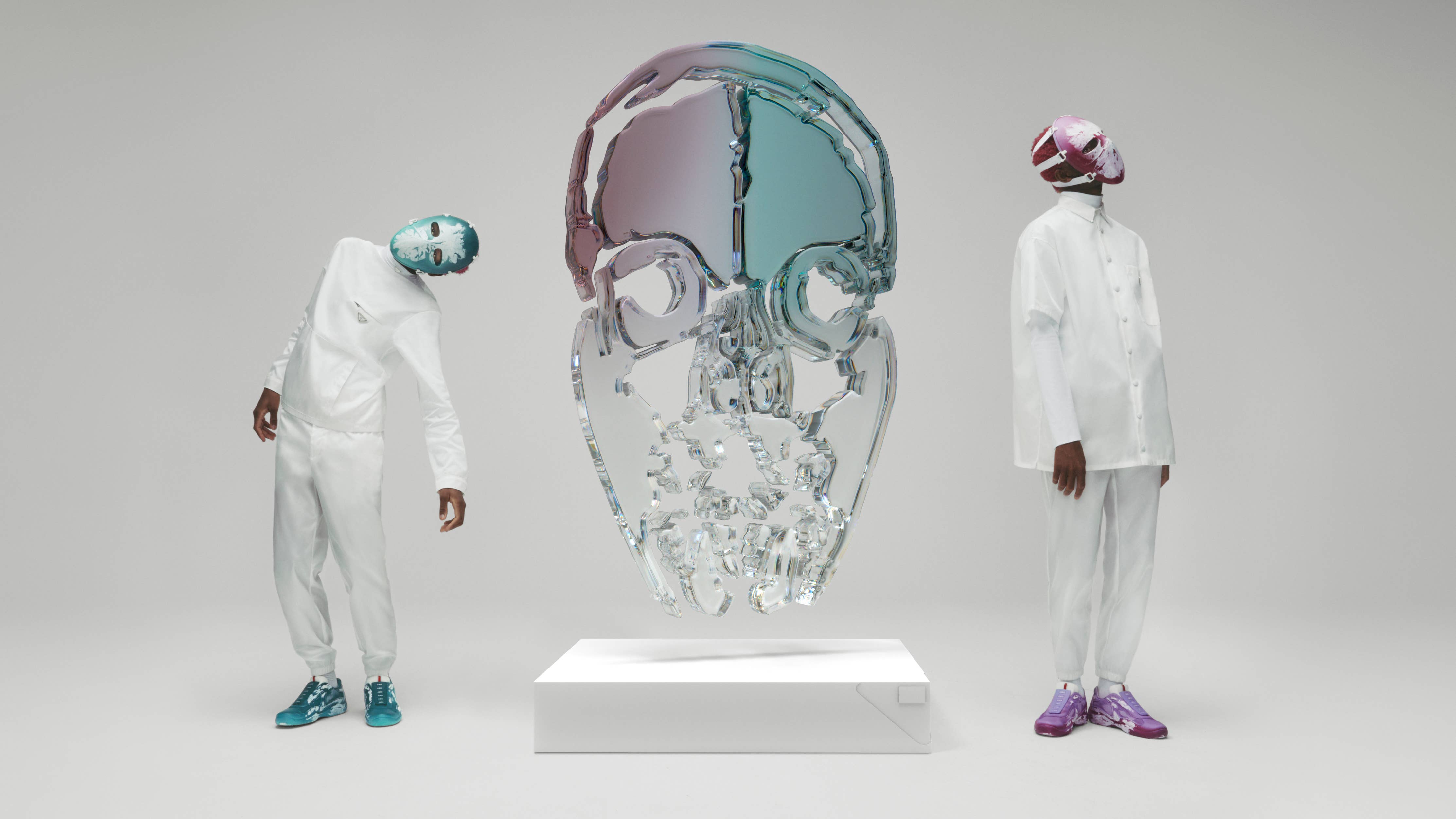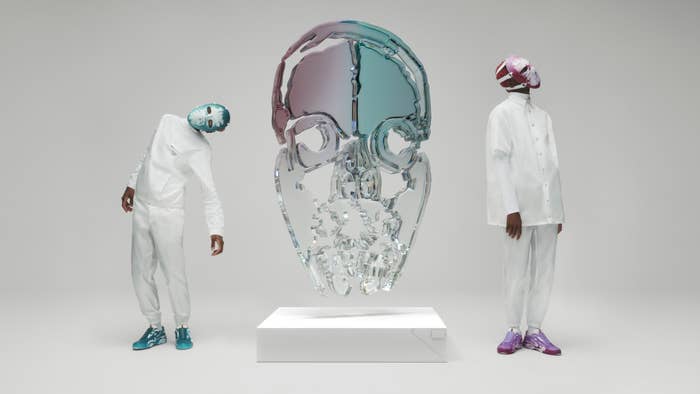
Though still in his early 20s, artist and sneaker customizer Cass Hirst has already created a unique visual code. Where many sneaker customizers rely on precise paint placement and technical reconstructions, Hirst’s style is more organic, if just as well considered. Instead of imposing his vision via precision brush strokes and X-Acto knives, Hirst prefers “when things line up naturally,” spraying colors on his shoes to create textured, gradient finishes that hum with visual energy.
This spring, Hirst brings that technique to a limited edition selection of Prada America’s Cup sneakers, using his skills to transform the clean, athletic shoe into something more naturalistic. Here, four versions of the America’s Cup each represent a different part of the envelope—or lifecycle—of a sound. From the sharp, neon molded spikes of the ATT4CK shoe to the stripped, distressed leather of the D3CAY and the overpainted brights of the SUST4IN model to the neon-spray finish of REL3ASE, each shoe is a creation unto its own, that also fits neatly into the collection as a whole.
Curious to learn more about his Cass x Prada America’s Cup capsule, we reached out to Hirst—who is the son of renowned contemporary artist Damien Hirst—to talk to him about his process, his inspirations, and even why fingerboarding remains one of the last true subcultures. Check out what he had to say below, then keep your eyes out for the May 17 Cass x Prada drop—limited to 3,000 pairs globally—at select Prada boutiques and via prada.com.
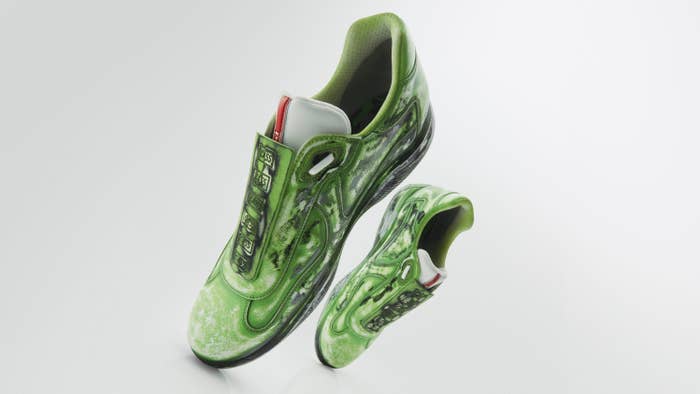
When I think of the Prada America’s Cup sneaker, I envision a technical athletic shoe, often in patent leather. Your versions retain that sporty silhouette, but with the spray techniques you use, they appear very handmade and worn in, which is a contrast to that shiny, technical look. Was that an intentional departure from the original design for you? Or did you just sort of trust your style and intuition to get that outcome?
It was mostly a case of trusting myself and experimenting, However the original design of the shoe was a big part of it. I wanted to take it to a more hectic place, which was a challenge considering how clean the shoe is. I also didn’t want to make it so chaotic that it’s unappealing—balance was a big part of the decision making. I love the D3CAY series mostly because it steers so far from the original design and still accentuates the design of the shoe. It’s fun to see how far it can be pushed.
The America’s Cup quickly became a Prada hallmark when it dropped in the late ’90s. As someone who wasn’t born when the original came out, how did you approach redoing such a well-known shoe? Did that history sort of loom over you or were you excited to put your own spin on it, almost like a total refresh on the model?
I went into this shoe totally blind to be honest. I’d had very little interaction with the America’s Cup sneaker before this project and I went straight to painting them in the studio, probably before even wearing them. I think that helped me to find my love for the shoe visually and personally, rather than researching its history and understanding what it means to the world.
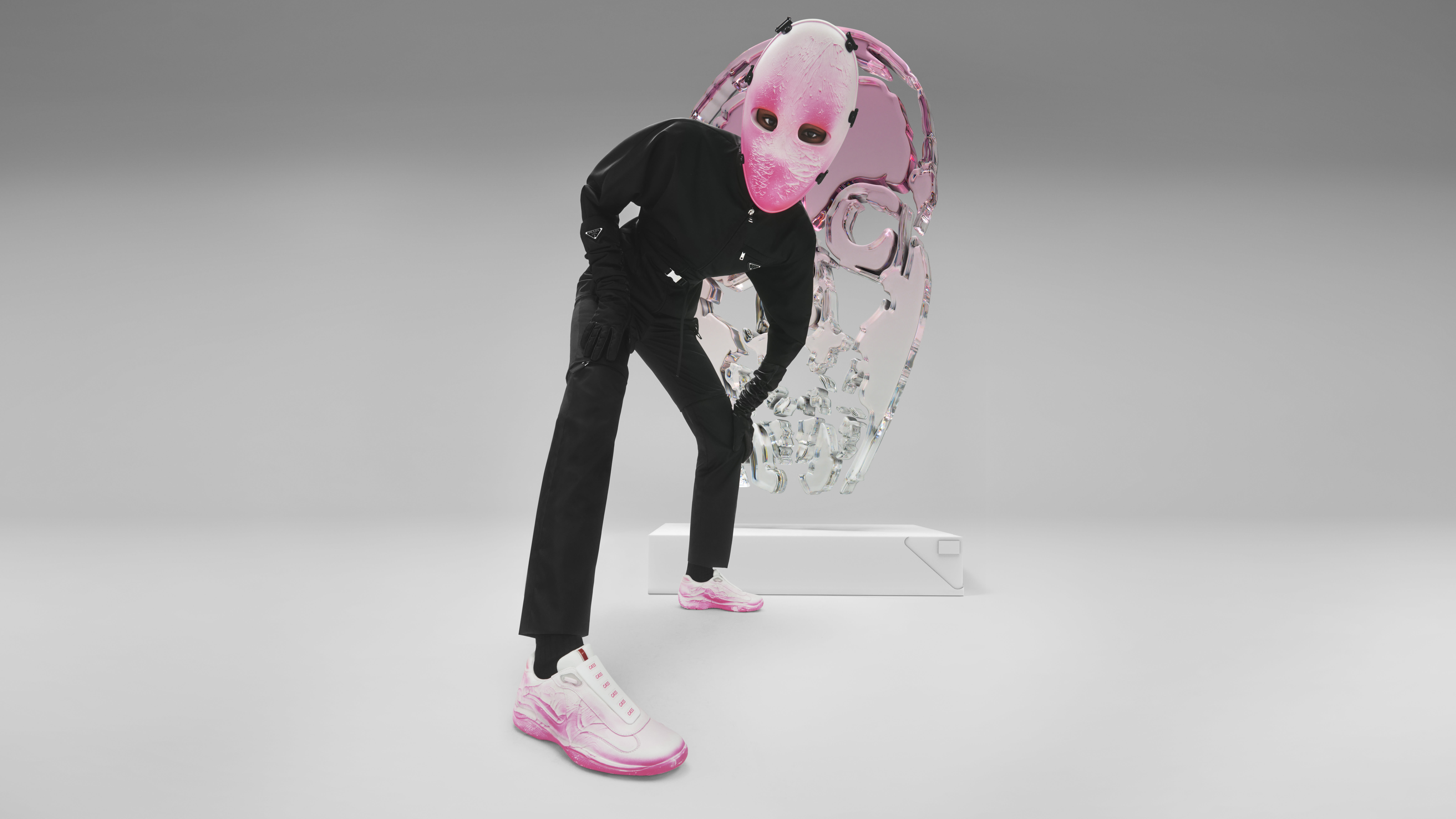
And then going back to your artistic style. Your sneaker designs are all very unique and individualized. No two appear exactly alike. Why do you think that hyper-custom look is something today’s sneaker fans value so much? Is it about standing out? Or is it more personal and private, like valuing something only you have?
I think uniqueness is so important these days. Maybe people need it because of how much copying and following there is at the moment. I think people love to stand out, but they also want to feel like they’ve been thought about in some way. Throughout the whole project I kept thinking about what it would be like to open a pair of these, which is why I’ve chosen to have softer, painted insoles in the shoes, painted lace-ends, a poster within the shoebox and a box that’s been printed on the inside and the outside. I’ve opened shoeboxes before and I know how amazing it can feel when everything has had extra thought put into it.
Prior to customizing sneakers, what were your experiences with art and design?
I spent my last two years of education focusing heavily on graphic design, photography, and art—having three projects on the go at the same time was intense but fascinating. I also did 3D design at school, which I loved but unfortunately couldn’t do as an A level. Other than that my experiences of art and design mostly came from my childhood—spray painting skateboards when I was 11, or drawing miniature graffiti pieces on fingerboard ramps. I think everything merged together once I finished school though. Seems like the lines between everything no longer exist. It’s nice.

And with your designs being hand-sprayed, how much did you work with spray paint and graffiti or even airbrushing before turning your attention to sneakers?
I’ve messed around with graffiti for years but never gone in very deep. I spent a few years attempting to master lettering styles and ended up learning a lot, but it’s always been super challenging. I’ve never really been too interested in airbrushing, although I did recently purchase a more heavy duty spray gun that can cover a lot more ground than your standard airbrush. I need to have another go with that soon. I think airbrush is just too slow for me; I want to work quickly and I want there to be consistency within my strokes. I could spend more time with airbrushing and get better at it but when spray paint gives me such good results, why would I?
Beyond that, I read that you grew up skateboarding and loving skate shoes. That’s interesting to me because the Prada America’s Cup inspired at least one pair of famous pro skate shoes in the mid 2000s. Did that background in skateboarding, where everything is so organic and DIY, inspire your sneaker designs for Prada?
I think it definitely did in one way or another. Skating made me think a certain way when I was younger—that way you look at the world when you want to just mess around. I remember skating a fridge door in the garden with my friend George when I was younger. It sounds so stupid, and it was fairly stupid, but I was always looking around for stuff to skate. It makes you view everything from a different perspective when you’re stuck at home desperate to skate. I definitely think that DIY mentality plays a part in my mind today and must’ve helped me at some point when coming up with these designs.
I think skating a fridge door sounds awesome, actually. Outside of skateboarding, have you ever participated in any other subcultures? Did those things influence your Prada designs at all too?
I think the only other subculture I’ve been heavily involved in is fingerboarding. It’s like a subculture within a subculture—very niche. Meeting someone else who fingerboards is fairly rare, which I like. It keeps it special. Did fingerboarding influence these shoes? Probably in some way. I definitely spent a lot of between-time fingerboarding in the studio, waiting for paint to dry.
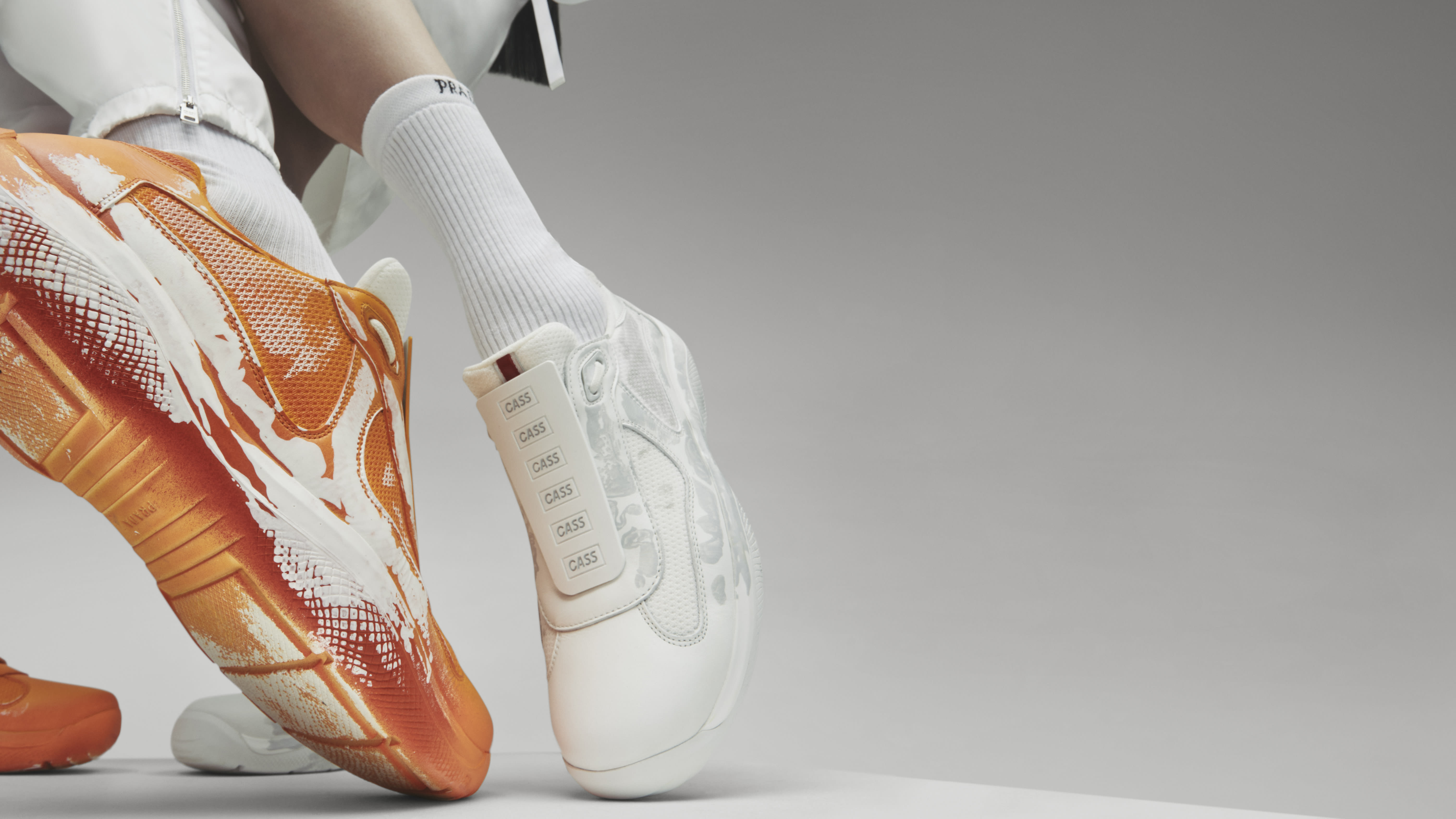
My favorite thing about your America’s Cup designs are how they work as individual objects unto themselves, but are also so clearly part of a set. Each one of the four shoe designs almost interlocks with the other. And then, the names of the shoes—ATT4CK, D3CAY, SUST4IN, REL3ASE— which refer to “the ‘envelope’ or life of a sound and the stages of its evolution,” seem to indicate that framing was intentional. Can you talk more about that and how you conceptualized the shoes not only as a set, but as part of a “lifecycle”?
I’m glad you can see the interlocking of the series. It feels that way to me too. It wasn’t a plan from the beginning to have them interlock like this, but once the names and numbers were decided it all started making perfect sense. I prefer when things line up naturally in front of me, rather than working to force things into their place.
I like the term “lifecycle” and it does feel relevant to the series. The perfect thing about creating multiple colourways for a single shoe is that the base is always the same, so no matter how far the designs go, they will always be connected by the base—like how animals have endless variations of a single species. It’s just evolution really. I knew while coming up with the designs that the natural evolution would be there, since the series is bound together by the base shoe and my art. It’s why I love looking at them as a family.

And I know your logo, which will be used on the Prada America’s Cup boxes, is a brain scan. Can you talk about that symbolism and what it means to your work and designs?
Truthfully, the symbolism doesn’t mean too much to me. If I think about the truth of it and where it came from, then I know the meaning is there, but to me it’s just a cool logo. It’s that same thing of preferring when things just line up naturally—I took advantage of having to get endless tests done in the hospital and used them as imagery, this is just the one piece of imagery that I held onto.
Nothing wrong with that. A cool logo is crucial and it’s important to enjoy things simply because they’re cool. So then, to close things out, how would you wear your Prada America’s Cup designs? If you were pulling a Prada fit to go with the shoes, how would you style it?
The perfect thing about these shoes is that there are endless outfits that would go crazy with them. I think I’ll probably balance between wearing excessive color-matched outfits and wearing full black outfits. Both would be amazing with any of the shoes.

